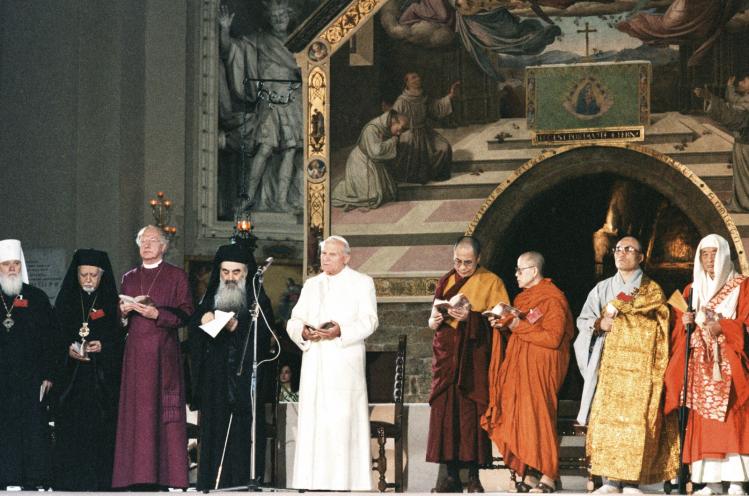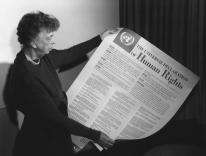
This article is adapted from the forthcoming book Religion as We Know It: An Origin Story, which will be published by W. W. Norton this month. Used by permission. All rights reserved.
Gods here?
Who can know?
Not I.
Yet I sigh
and tears flow
tear on tear.
—Saigyō Hōshi (1118–1190), on visiting the Grand Shrine at Ise.
The United States of America practices many religions, and pluralism in American usage is a term that aims to turn the arguably neutral fact of plural religions into an American value: pluralism. If an American favors pluralism, in other words, then he or she thinks it good rather than bad that America practices many religions and would regret rather than applaud the replacement of the nation’s many religions by some one religion, even his or her own.
Do Americans in fact favor pluralism? Many surely do, if no doubt to a somewhat varying degree. Nonetheless, nearly ten years ago, when newly appointed as the general editor of the American reference work later to be published as The Norton Anthology of World Religions, I chose to assume that American pluralism enjoyed the support of at least a comfortable majority. A majority of Americans, I chose to assume, would welcome a work taking the multiplicity of American religion as not just as a bare fact but also, on balance, as a good thing in our moment of cultural globalization.
I haven’t abandoned that assumption. Yet now that my general introduction to the NAWR is being published as a slender, separate book titled Religion As We Know It: An Origin Story, the moment is at hand to reveal how a nagging, complicating background thought both challenged that first assumption in a surprising way and further shaped the work that W. W. Norton & Company eventually published.
At the time when Norton approached me about undertaking this work, I had been involved in the study of religion for several decades and had taken part in innumerable public discussions of the subject. What nagged at me was something that had occurred repeatedly in those discussions. Time and again, I had heard someone rise to say that one religion or another “is not a religion in the usual sense of the word” or “not a religion in the mainstream sense of the word.” An alternate formulation would sometimes be “is not a religion, it’s a way of life.” Still another would be, “is not a religion, it’s just a part of being x,” where x would be a national identifier. Finally, a frequent formulation would be simply “is not a religion in your sense of the word,” with the referent of “your” left quite vague. Whom did the speaker have in mind?
A given speaker might go on to make a perfectly plausible case for why Hopi folk belief and ritual or Shinto or Daoism or some form of Hinduism or even Judaism was misconstrued when taken to be a religion in the usual sense of the word. But who owned that usual sense? Where had it come from? And did it not claim at least enough continuing validity or relevance to bring people of diverse religions together for discussion and debate?
That question did have to be asked, for why assemble people from various religions to talk of any one religion when that religion is then declared not to be a religion in the first place? And what happens to the notion of pluralism if, in fact, there does not exist a plurality of different religions but only a plurality of miscellaneous activities, all of which people have for some perverse reason been calling religions? And, by the way, who are these presumptuous people? Where and how did they receive or invent their usual sense of the word? And how has their sense of the word acquired such widespread acceptance that speakers still find it necessary to formally dissociate from it? American culture, by the term pluralism, has clearly embraced the threefold notion that there are, yes, many different religions; that they are all somehow comparable to one another; and, crucially, that they are all more or less welcome in the United States. Has this embrace been somehow a huge cultural mistake?
Finally, I had to wonder, when speakers dissociated themselves from the term “religion,” did the dissociation actually work? It often seemed to me that speakers who repudiated the applicability of the word “religion” to their particular non-religion would later circle back and use the word in spite of themselves in the very sense that they had repudiated. However objectionable, had the word in the usual sense become somehow unavoidable or indispensable?
Early in my introduction to The Norton Anthology of World Religions, the reader encounters the following deliberately casual and unchallenging sentence:
What is religion? The word exists in the English language, and people have some commonsense notion of what it refers to. Most understand it as one kind of human activity standing alongside other kinds, such as business, politics, warfare, art, law, sport, or science.
My decision for the organization of The Norton Anthology of World Religions was that we would begin with this “commonsense notion” rather than with a theoretically ambitious definition of religion—an academic definition that I would then be required to impose on my six associate editors, each of whom was far more learned than I about one of the six traditions anthologized. My decision was, first, to acknowledge that various competing academic theories of religion define the word quite differently; second, to note that no theory, no definition, had acquired universal acceptance; but then, third and at length, to proceed to give this very commonsense notion, however academically objectionable it might be, as plausible a history as I could manage, stretching back to its very beginning and forward, at the very end, to the twentieth-first century. The result was an origin story.
What makes the everyday American understanding of religion objectionable when extended to cultures very different from the American or European can be traced to the phrase “one kind of human activity alongside other kinds.” This ostensibly innocuous phrase has an explosive, disruptive potential because it asserts that religion stands indeed alongside the other activities mentioned—in other words, that it is separable from and distinguishable from them. But this is just the assertion that turns out to be objectionable when applied to “religions” that are practiced in a way or in a context that makes them indistinguishable and inseparable from business, politics, warfare, law, and so forth down a familiar list of human activities, not to speak of such larger background realities as language, calendar, marriage, diet, and nationality.
Over the years, those speakers whom I had found most clarifying and instructive, though they may have puzzled me at the time, were those who adopted a stance of disputatious protest against either Christian missionary activity or related Western colonialism and continuing cultural hegemony. Such would be my experience when I would hear an Indian speaker say, “What you people call Hinduism is for me just part of being Indian”; or when I would hear a Jewish speaker say, “Judaism is not a religion, Judaism is a way of life.” Hopi religion exists only in the Western Hemisphere, but I once heard a student of that religion say, and with good reason, “The Hopi do not have a religion in the Western sense of the word.”
Western in that sentence referred not to geography but to culture—namely, to the European culture that started to spread around the world with the great Spanish and Portuguese explorers of the late-fifteenth and sixteenth centuries and went on, through later colonialism and the spread of Western ideas of all kinds, to dominate much of the world. This culture, Western culture, has long approached religion in a way profoundly shaped by Christian assumptions, and Christianity had indeed, and very early on, introduced a separation of what it chose to regard as religiously significant from the rest of its adherents’ worldly lives. This being the case, the story of how just that artificial separation was made for the first time and then how the habit of making it spread to Europe and outward from Europe—through both missionary activity and secular Western colonialism—becomes the origin story of “religion as we know it.” To say that it spread is not to say that it was always welcome, but neither is it to deny that it was often enough borrowed or—its Christian origin quite forgotten—simply taken for granted. Cultures, after all, do borrow from one another and, over time, assimilate and indigenize what has been borrowed. Western coinages like Hinduism, Buddhism, Daoism, and so forth do undeniably squeeze large, complex social and historical realities into the frame of religion as we know it, but at this late date, thanks to globalization and international migration, the option of simply retiring or retracting such terms scarcely exists. The affected populations themselves now have ownership rights and would exercise them.
The “origin story” of Religion As We Know It is told largely in a long section titled “How Christian Europe Learned to Compare Religions,” just as it originally was told in a section by the same title in the general introduction to The Norton Anthology of World Religions. Early in that section, I wrote:
Through most of world history, in most parts of the world, what we are accustomed to call religion, ethnicity, and culture have been inextricable parts of a single whole. How did Christianity begin to become an exception to this general rule? On the one hand, it appropriated a set of Jewish religious ideas—including monotheism, revelation, covenant, scripture, sin, repentance, forgiveness, salvation, prophecy, messianism, and apocalypticism—without adopting the rest of the Jewish way of life. On the other hand, it universalized these Jewish religious ideas, creating a new social entity, the church, through which non-Jews could be initiated into an enlarged version of the ancestral Jewish covenant with God.
With hindsight, I would now like to refine or extend this claim in three regards.
First, the Jews who founded Christianity began most clearly to abstract the mentioned set of “religious ideas” from the rest of the Jewish way of life in the process of admitting non-Jews to their revised and enlarged sense of the Jewish covenant with God. Jews who became Christian simply by recognizing Jesus as the Jewish Messiah did not at that moment or by that action cease living as Jews. But then, by the same token, Egyptians or Armenians or Macedonians who later embraced a set of dynamic Jewish ideas as part of accepting Jesus as the Jewish Messiah were not required by that act to become Jews or to cease living in other regards as Egyptians or Armenians or Macedonians. Yet the embrace by so many non-Jews of these originally Jewish ideas almost certainly had the effect over time of severing those ideas not just from the rest of the Jews’ way of life but also from the rest of anyone’s way of life. To be sure, an almost equally powerful tendency toward reintegration would repeatedly bring about the fusion of Christian identity with the way of life of one nation or another, even one empire or another. Nonetheless a consequential severing took place in principle and could reassert itself at any time.
Second, the act of abstracting Jewish religious ideas from the rest of a rich and complex Jewish way of life had the tacit effect of defining the rest of that way of life as somehow not religious. For centuries, Jews had distinguished their own true, native worship from the false, alien worship of all others. But now there arose a distinction not between the Jewish God as the one true or “living” God and other purported gods but between the religiously consequential or essential parts of the Jewish way of life itself and the rest of that way of life, now taken to be not wrong but only religiously inconsequential or nonessential. This distinction when first made did not amount to a full-fledged distinction between the religious and the secular, but it laid the egg from which that immensely influential later distinction would hatch.
Before that point would be reached, Medieval Europe would for centuries incarnate the same key distinction by dividing the personnel of Christendom into the “religious” (monks and nuns) and the “laity” (everyone else: all those engaged in “worldly” pursuits). The Protestant Reformation would challenge this distinction, honoring once worldly pursuits as no less holy in principle than formally religious pursuits and the laity, who engaged in such worldly pursuits, as no less holy in principle than the clergy. The Protestant challenge had, to be sure, lasting consequences. However, the “Great Secularization” of the late-seventeenth and eighteenth centuries would paradoxically revive and embrace the prior distinction while gradually elevating secular pursuits above religious ones. Secularization has been a profoundly transformative cultural process, and yet the transformation has necessarily reinforced the originally Christian notion of religion as separable from the range of other pursuits whose autonomy secularization has so insisted on.
Third, the early-modern study of world religions beyond the West was at first essentially the study of those religions naïvely taken as exotic versions of a reality whose domestic version was Christianity. That is, it was the uncritical study of the non-Christian religions of the world as if they all routinely understood themselves to be, like Christianity, separate domains open for adoption by any sincerely interested party. By this assumption, the religions of South and East Asia and the indigenous religions of Africa and the Americas were misconstrued rather as Christendom had long since misconstrued Judaism, Greco-Roman polytheism, and—to a degree—even Islam. In more recent centuries, more sophisticated students of religion have quite successfully challenged this naïve assumption. Thanks to a substantial academic literature, a more integralist understanding has taken hold which posits that religion, culture, and ethnicity are de facto often found in a fusion so seamless and taken for granted that its practitioners scarcely even have a name for it.
Yet the now solidly established Western assumption that law, politics, art, science, and so forth are inherently autonomous activities, independent of, and by all means to be kept separate from, the increasingly sequestered realm of religion, has remained influential far beyond the geographical West. Autonomy from religion for all these activities—a derivatively Christian notion whose ancestry is now rarely remembered—has been a crucial element in the rise of modernity. And the encounter with modernity has in turn occasioned a crisis in the histories of all six of the major living, international traditions that Norton anthologizes—beginning, of course, with Christianity itself. In this way, the West—and behind it Christianity, and behind Christianity, Judaism—has been both a disruptive and a formative force in cultures once untouched by the notion of religion as “we” (of the West) know it.
Now, to say that religion is a separate domain is not, when all is said and done, to say all that much about it. If this notion, now so much a part of American common sense about religion, arose somehow two thousand years ago in the abstraction of a set of Jewish religious ideas from the rest of the Jewish way of life, how did those Jewish ideas arise in the first place? What was their source? And if other, contemporaneous or earlier or, for that matter, much later societies developed other, different semi-religious or quasi-religious or equivalently religious ideas, did they all spring from the same source? What is the origin story behind these origin stories, and how far back in human evolution must we go to find it? Was religion an adaptive or maladaptive behavior for prehistoric Homo sapiens? Is its taproot individual or social? If social, can it be regarded as a human social analogue to some of the extravagant, sometimes maladaptive but nonetheless durable animal mating rituals described in Richard O. Prum’s The Evolution of Beauty? Has religion, like the peacock’s tail and like art in all its wasteful madness, been a part of how societies survive, thrive, and reproduce themselves over time?
Questions like these can so very easily be multiplied. They are entirely legitimate and even deeply engaging. To ask them, however, is to ask about religion not as we know it but rather as we might now proceed to study it. It is to admit that we do not fully understand religion any more than we fully understand such other deep-rooted, universally attested human behaviors as language, art, and play. The Norton Anthology of World Religions acknowledges the existence and importance of theories of religion that attempt to answer these questions but does not explore the answers themselves. The goal of the introduction, now published separately, is simply to trace religion “as we know it” to its origin, then to follow the story of its growth and its spread, and, finally, to acknowledge how this powerful but undoubtedly limited way of knowing has both enabled comparison and distorted it down to our own day. The resulting origin story has some of the interest that all origin stories have. It matters most, however, because its darker consequences linger longer the more they are ignored.
Please email comments to [email protected] and join the conversation on our Facebook page.
Previous Story
The Common Good or Capitalism?
Next Story
St. Ephrem’s Lament


